Emerging from the Barents Sea, Svalbard is an archipelago located roughly halfway between mainland Norway and the North Pole, consisting of nine islands that remain perpetually frozen in the High Arctic. This stunning region is largely untouched wilderness, marked by massive glaciers, steep mountains, deep fjords, and desolate tundra. Beyond the main settlement of Longyearbyen—where exploration without polar bear protection is prohibited—and a few small communities, there is little evidence of human presence. Although it belongs to the Kingdom of Norway, Svalbard has a unique, isolated feel that makes it a must-visit destination for adventurous travelers eager to discover the wild extremes of Scandinavia. Here’s everything you need to know about planning your trip to Svalbard.
Browse Svalbard holidays
How to get there
Svalbard Airport: the northernmost airport in the world with regular commercial flights
Despite its remote location, reaching Svalbard is surprisingly straightforward. Both Scandinavian Airlines and Norwegian offer regular flights to Longyearbyen from Oslo (about three hours) and Tromso (approximately an hour and a half). Typically, travelers spend a night in either city before departing to Svalbard the next day, though you can extend your stay to explore more of Oslo or Tromso if time allows.
Keep in mind that while Svalbard is part of Norway, it is not included in the Schengen Zone. Thus, you will go through passport control in either Oslo or Tromso when entering or exiting Schengen. Even on a direct flight from Oslo, there might be a brief stop in Tromso along the way. Once you arrive in Svalbard, a shuttle bus can take you to central Longyearbyen in just 10 minutes. Taxis are available but are more expensive and not significantly faster, as there is minimal traffic in this region.
When to go
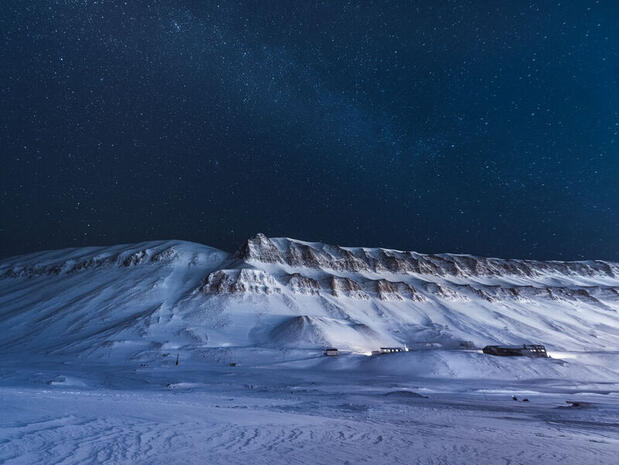
No sunlight in Svalbard from mid-November to mid-January
Svalbard experiences remarkable seasonal variations, making it essential to choose your visit based on what you wish to experience. From approximately April 20 to August 23, the sun remains above the horizon, granting Svalbard continuous daylight for over four months. This period, known as Polar Summer, allows for activities like hiking, cycling, and boating, with comfortable temperatures above zero.
Autumn is brief but beautiful, as sunsets return and the tundra transforms into golden and copper hues, accompanied by early snowfall on the mountain peaks. Days grow shorter in October, culminating in the last sunset of the year, signaling the start of Polar Night. While it may seem completely dark, there is an enchanting twilight phase known as ‘Blue Hour’ when the sun dips just below the horizon, offering stunning blue light around midday.

February is one of the best months to visit Svalbard
Days gradually lengthen in February, and locals celebrate the sun’s return as its rays peek over the mountain tops in early March. This timeframe, extending from February to April, is ideal for visiting Svalbard, with abundant daylight and a blanket of snow perfect for snowmobiling and husky sledding—activities typically unavailable during the early Polar Night months. Winter temperatures usually range from -10°C to -20°C, which, thanks to the warming effects of the Gulf Stream, are milder than in many areas at similar latitudes. However, temperatures can plunge below -30°C during particularly cold spells, so packing high-quality layered clothing is crucial.
Discover Svalbard in Polar Night
Can you see the Northern Lights?
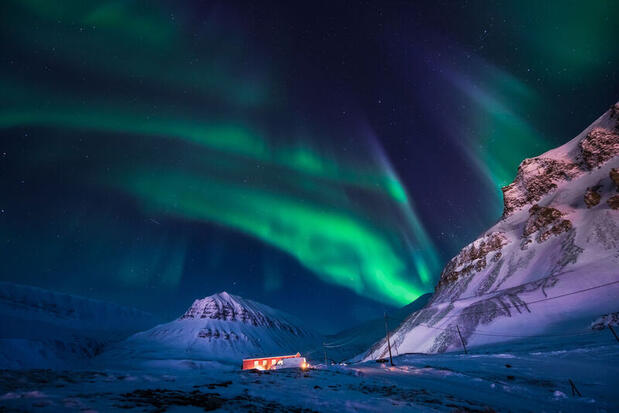
The Northern Lights are frequently visible in Svalbard during winter
Yes, witnessing the Northern Lights in Svalbard is certainly possible, although it may not be the ultimate destination solely for this purpose. Due to Svalbard’s extreme northern latitude (Longyearbyen is situated at 78˚N), it is slightly outside the auroral oval, which generally encompasses the latitudes between 60-75˚N. Therefore, travelers are more likely to observe breathtaking Northern Lights in mainland Norway, Finland, or Sweden. However, during the depths of Polar Night, you can see the lights at almost any hour, and they may appear in any direction, even toward the south. With minimal light pollution, you won’t have to venture far for an excellent view, should the aurora make an appearance.
How long to go for
We recommend a minimum stay of three nights in Svalbard, but if your schedule permits, extending your visit to four or five nights will be beneficial. This longer duration allows more opportunities for various excursions, exploring Longyearbyen, and truly experiencing life in the High Arctic. Given the unpredictability of the weather—particularly in winter—a longer stay also provides more flexibility to adjust your plans as necessary.
Where to stay
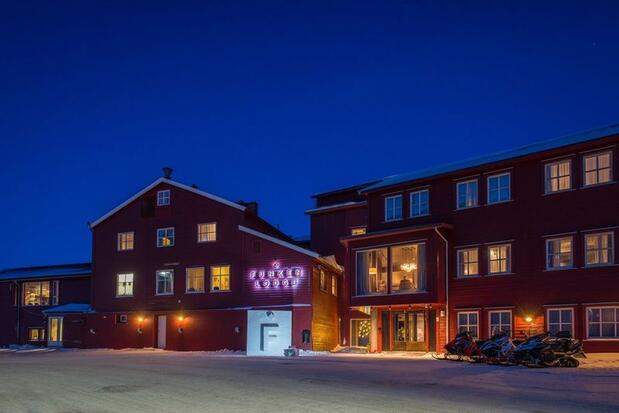
Funken Lodge, Longyearbyen
Considering its small size, remote location, and challenging environment, Longyearbyen offers a surprisingly diverse array of accommodation options. Choices range from converted miners’ cabins and rustic expedition-themed hotels to stylish, modern lodgings. Funken Lodge, perched on a hill outside the town center, is a standout, featuring a wonderful bar and restaurant. The Radisson Blu Polar Hotel is another excellent choice, boasting its own restaurant, gastropub, and outdoor hot tubs. If you seek a cozy, traditional atmosphere, consider Basecamp Hotel, designed to evoke the charm of a trapper’s cabin. For a truly unique wilderness experience, you can stay outside Longyearbyen at Isfjord Radio, an off-grid, boutique retreat on Spitsbergen’s west coast.
Things to do
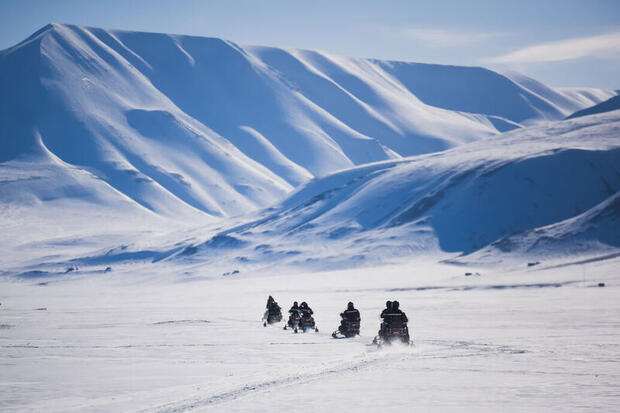
Snowmobiling through Svalbard’s frozen wilderness
The best ways to explore Svalbard’s icy wilderness include snowmobiling and husky sledding. If time permits, try both experiences, as they offer completely different adventures. Snowmobiling is faster, offers an adrenaline rush, and allows you to cover greater distances. In contrast, husky sledding lets you appreciate the breathtaking scenery at a leisurely pace and spend quality time with the dogs before and after the ride. Most excursions last from two to four hours and typically include a break for hot drinks and snacks, as well as high-quality thermal suits, boots, and gloves to keep you warm. For those looking for a full day of adventure, it’s also possible to arrange an all-day snowmobiling expedition to the east coast. While polar bear sightings are always a possibility, encounters are not guaranteed, and it’s strictly prohibited to approach or track them. You are more likely to see wild reindeer roaming the landscape.
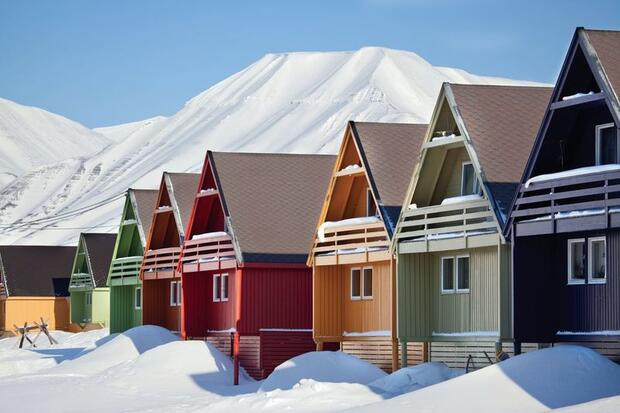
Colorful houses in Longyearbyen
Other popular activities include exploring Svalbard’s stunning underground ice caves, checking out abandoned coal mines, snowshoe hiking, and visiting the Global Seed Vault—a fortified structure embedded in the permafrost just outside Longyearbyen, which houses over a million seed samples from across the globe. While you cannot enter the vault itself, you can join a guided tour or hike that takes you close to its entrance. Be sure to set aside several hours to stroll around Longyearbyen, enjoying its colorful architecture and getting a taste of life in the world’s northernmost town. You might even stop for coffee and cake at Café Huskies! For a deeper appreciation of Svalbard’s history, consider visiting the well-curated Svalbard Museum. For those interested in local brews, a tasting experience at Svalbard Bryggeri, the world’s northernmost brewery, is also worth considering.
Always keep in mind that polar bear protection is mandatory when venturing beyond the settlement’s boundaries, marked by warning signs stating ‘Gjelder hele Svalbard’ (this applies all over Svalbard). The most photographed sign is located about a 15-minute walk from the center of Longyearbyen on the road heading east. Generally, excursions outside Longyearbyen are conducted with a qualified local guide.
What to eat
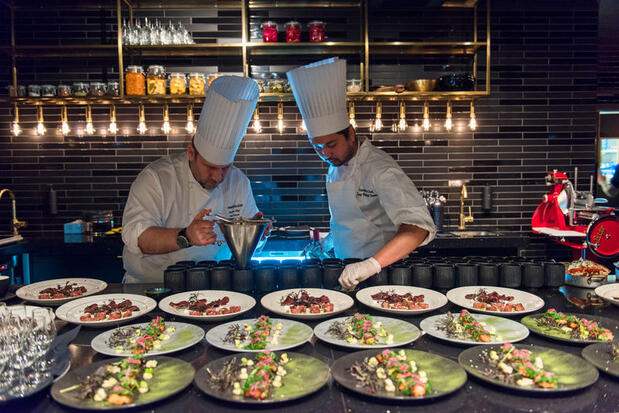
Dine at Funken Lodge (Credit: Agurtxane Concellon)
You might be pleasantly surprised by the variety and quality of restaurants, cafés, and bars available in Longyearbyen. Fine dining establishments like Huset, Funktionærmessen (located in Funken Lodge), and Gruvelageret serve high-end tasting menus that highlight seasonal Svalbard produce. Meanwhile, more casual options like Kroa, Barentz Gastropub, and Svalbar offer pizzas, burgers, and sandwiches alongside a selection of local specialties. Expect to see dishes featuring reindeer, seal, and whale meat on some menus, along with a variety of seafood—Atlantic cod is especially plentiful in Svalbard’s fjords.
At Lompen Senteret, Longyearbyen’s only shopping mall, you’ll find a Thai restaurant (Saenphet) and an excellent café (Fruene) that specializes in hearty lunch options, freshly baked cakes, and handcrafted chocolates. You can also find nearly everything you need at the well-stocked local supermarket, Svalbardbutikken.
Arctic Luxury in Svalbard: Across the Polar Land



